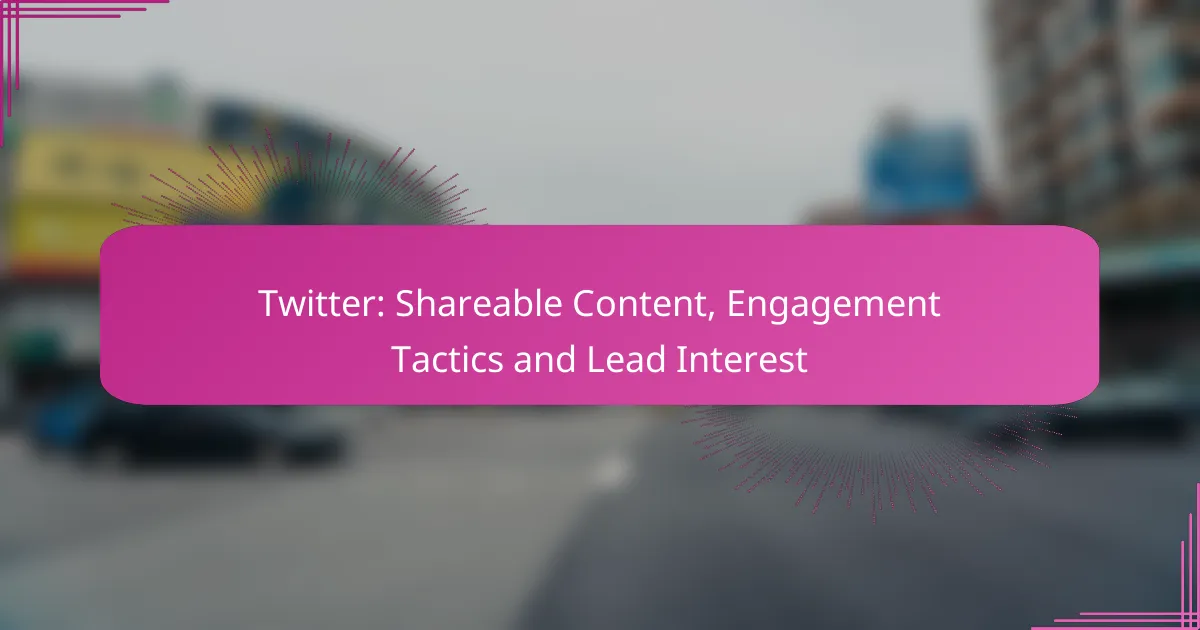Twitter is a powerful platform for creating shareable content that captivates audiences and drives engagement. By focusing on clarity and creativity, brands can produce visually appealing posts that resonate with users, encouraging retweets and interactions. Implementing engagement tactics such as interactive polls and timely responses can significantly enhance lead interest and foster a vibrant community around your offerings.
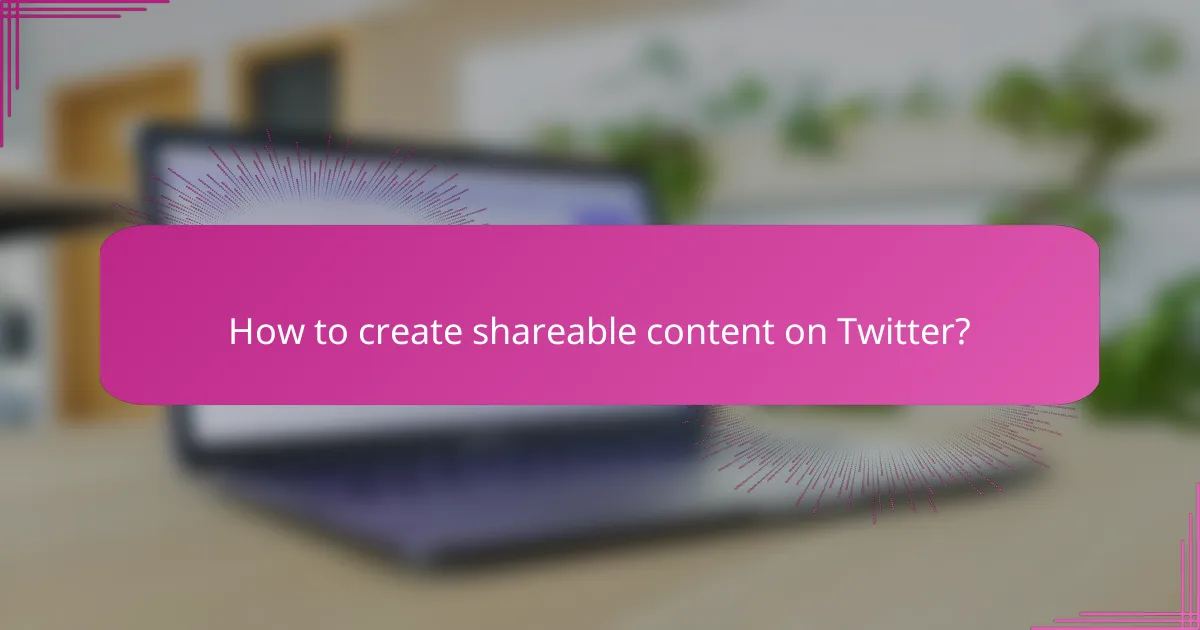
How to create shareable content on Twitter?
Creating shareable content on Twitter involves producing engaging, relevant, and visually appealing posts that resonate with your audience. Focus on clarity, creativity, and connection to encourage retweets and interactions.
Visual content strategies
Visual content significantly enhances engagement on Twitter. Use eye-catching images, infographics, and videos to capture attention quickly, as tweets with visuals are more likely to be shared. Aim for high-quality visuals that align with your brand identity.
Consider using tools like Canva or Adobe Spark to create custom graphics. Keep images under 5 MB for optimal loading times and ensure they are sized correctly for Twitter’s display standards.
Utilizing trending hashtags
Incorporating trending hashtags can increase the visibility of your tweets. Research current trends using Twitter’s search feature or tools like Hashtagify to find relevant hashtags that align with your content. Aim to use 1-3 hashtags per tweet for maximum impact without overwhelming your message.
Monitor hashtag performance and adjust your strategy based on engagement metrics. Engaging with trending topics can also position your content within broader conversations, attracting more shares.
Engaging storytelling techniques
Storytelling can make your content more relatable and memorable. Share personal anecdotes, customer stories, or case studies that highlight your brand’s values and mission. This approach fosters emotional connections with your audience.
Use a clear narrative structure: introduce a problem, present a solution, and conclude with a call to action. Keep your stories concise, ideally within a few tweets, to maintain interest and encourage sharing.
Timing and frequency of posts
Timing and frequency are crucial for maximizing engagement on Twitter. Aim to post during peak hours when your target audience is most active, typically between 12 PM and 3 PM on weekdays. Experiment with different times to find what works best for your followers.
Consistency is key; consider posting multiple times a day to maintain visibility. However, avoid overwhelming your audience by spacing out your tweets and ensuring each one adds value to the conversation.
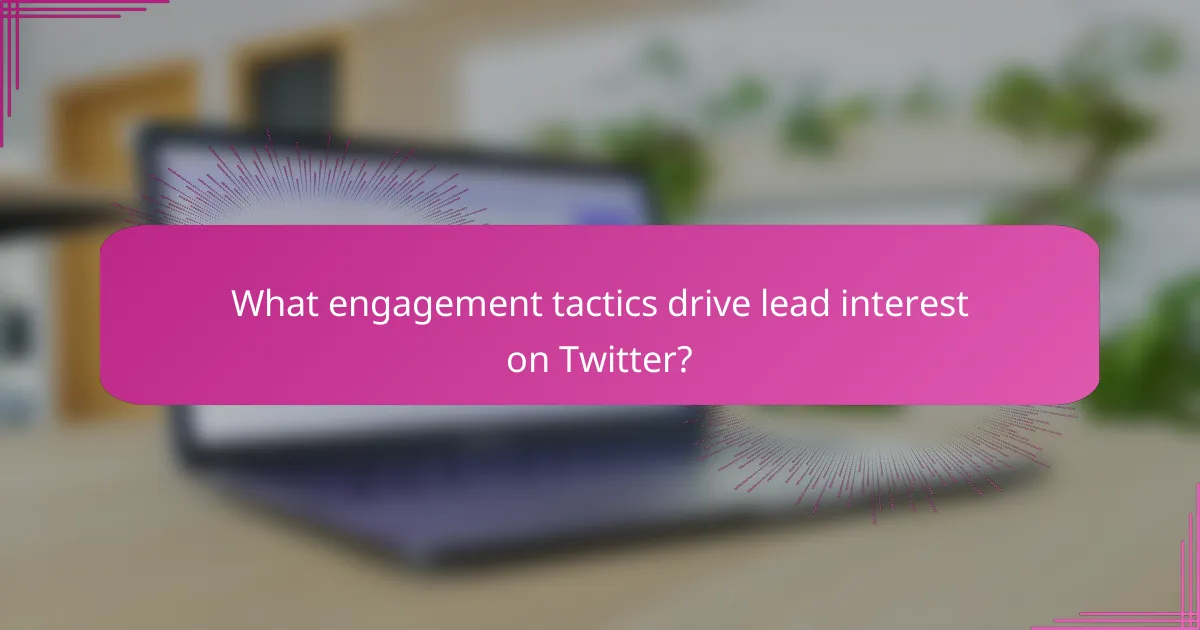
What engagement tactics drive lead interest on Twitter?
Engagement tactics that effectively drive lead interest on Twitter include interactive polls, timely responses to mentions and direct messages, and hosting Twitter chats. These strategies encourage user interaction, foster community, and can significantly enhance visibility and interest in your offerings.
Interactive polls and questions
Interactive polls and questions are a powerful way to engage your audience and gather insights. By asking your followers to vote on topics or share their opinions, you create a sense of involvement and encourage participation. For example, you might ask, “Which product feature do you value most?” to gauge interest and preferences.
To maximize impact, keep polls concise and relevant to your audience. Aim for a balance between fun and informative questions, and consider using visuals to enhance engagement. Regularly incorporating polls can lead to increased interaction rates and a better understanding of your audience’s needs.
Responding to mentions and DMs
Responding promptly to mentions and direct messages (DMs) is crucial for building relationships and demonstrating that you value your audience. Quick responses can lead to higher engagement and foster a sense of community. Aim to reply within a few hours to maintain momentum and show attentiveness.
When responding, personalize your messages to make followers feel acknowledged. Use their names and reference previous interactions if applicable. Avoid generic replies, as they can diminish the connection. This approach not only enhances engagement but can also convert casual followers into leads.
Hosting Twitter chats
Hosting Twitter chats allows you to engage with your audience in real-time discussions around specific topics. These chats can help position you as an authority in your field while fostering community interaction. Schedule these events regularly and promote them in advance to attract participants.
During a Twitter chat, prepare a series of questions to guide the discussion and encourage participants to share their thoughts. Use a unique hashtag to track the conversation and make it easier for others to join in. This tactic can significantly boost your visibility and lead interest, as participants often share insights with their own followers.

How to analyze Twitter engagement metrics?
To analyze Twitter engagement metrics effectively, focus on understanding how users interact with your content. This involves tracking likes, retweets, replies, and mentions to gauge audience interest and refine your strategy.
Using Twitter Analytics tools
Twitter Analytics provides a comprehensive dashboard that displays key engagement metrics for your tweets. You can access data on impressions, engagement rates, and audience demographics, which helps you understand what content resonates with your followers.
To utilize these tools, navigate to the “Analytics” section of your Twitter account. Regularly reviewing this data allows you to adjust your content strategy based on performance trends, ensuring you maximize engagement.
Key performance indicators to track
When analyzing Twitter engagement, focus on several key performance indicators (KPIs). Important metrics include engagement rate, which measures the percentage of interactions relative to impressions, and the number of retweets, which indicates content sharing.
Additionally, track the number of replies and mentions to assess direct audience interaction. Aim for engagement rates in the low to mid-single digits as a benchmark, but remember that context matters—different industries may have varying standards for success.
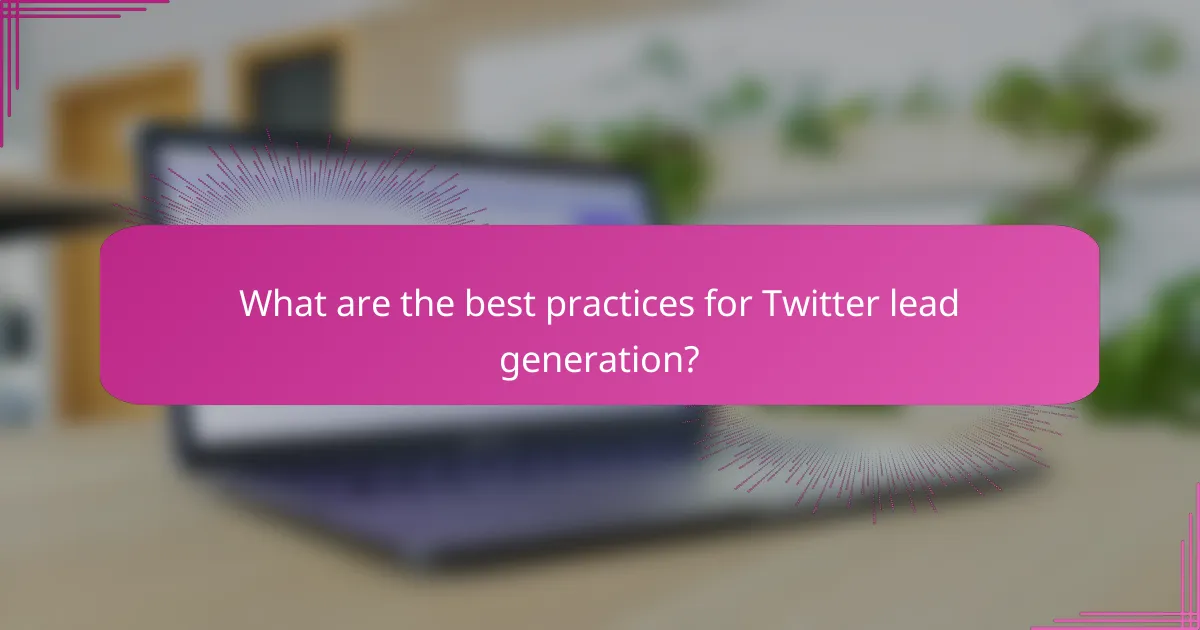
What are the best practices for Twitter lead generation?
Effective Twitter lead generation involves creating engaging content, utilizing targeted advertising, and optimizing your profile. By focusing on these elements, you can attract potential customers and drive interest in your offerings.
Creating targeted Twitter ads
Targeted Twitter ads are essential for reaching specific audiences likely to convert. Use Twitter’s targeting options, such as demographics, interests, and behaviors, to tailor your ads effectively. This ensures your message reaches users who are more inclined to engage with your brand.
Consider A/B testing different ad formats, such as image, video, or carousel ads, to determine which resonates best with your audience. Allocate a budget that allows for flexibility, starting with a few hundred dollars to gauge performance before scaling up.
Building a strong profile and bio
Your Twitter profile and bio serve as the first impression for potential leads. Ensure your profile picture and header image are professional and relevant to your brand. Your bio should clearly articulate what you offer and include a call-to-action, such as a link to your website or a lead magnet.
Incorporate keywords related to your industry to improve discoverability. A well-crafted bio can significantly enhance your credibility and attract followers who are interested in your products or services.
Leveraging Twitter lists for outreach
Twitter lists are a powerful tool for organizing and engaging with potential leads. Create lists for different segments, such as industry influencers, potential clients, or competitors, to streamline your outreach efforts. This allows you to monitor conversations and engage meaningfully with each group.
Regularly interact with users on your lists by liking, retweeting, or replying to their tweets. This builds rapport and increases the likelihood of them considering your offerings. Aim to add new contacts to your lists consistently to expand your reach and influence.
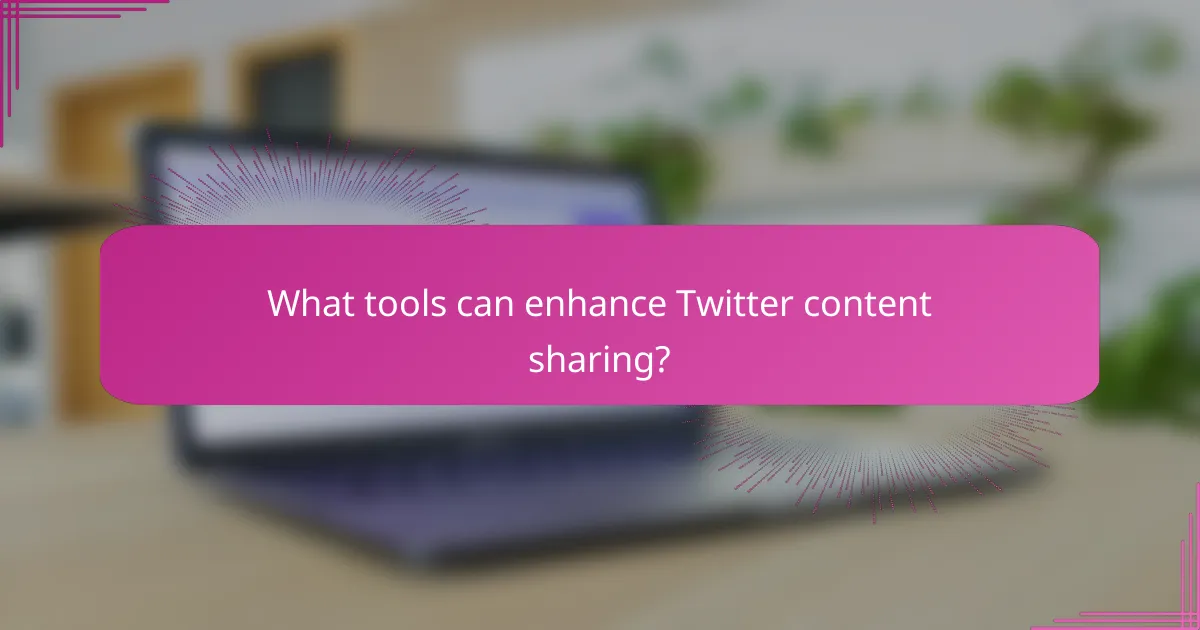
What tools can enhance Twitter content sharing?
Several tools can significantly improve Twitter content sharing by streamlining scheduling, enhancing visuals, and monitoring engagement. Utilizing these tools effectively can lead to increased interaction and interest from potential leads.
Buffer for scheduling posts
Buffer is a popular tool that allows users to schedule Twitter posts in advance, ensuring consistent content delivery. By planning posts at optimal times, you can reach a larger audience and increase engagement rates.
To maximize Buffer’s effectiveness, analyze your audience’s active hours and schedule posts accordingly. Avoid overwhelming followers by spacing out posts throughout the day, ideally targeting peak engagement times.
Canva for graphic design
Canva is an intuitive graphic design tool that enables users to create eye-catching visuals for their Twitter content. Engaging images can significantly boost shares and interactions, making your posts more appealing.
When using Canva, focus on maintaining brand consistency with colors and fonts. Utilize templates tailored for social media to ensure your graphics are optimized for Twitter’s dimensions, enhancing visibility and shareability.
Hootsuite for monitoring engagement
Hootsuite is a comprehensive social media management platform that allows users to monitor engagement across multiple accounts, including Twitter. By tracking mentions, retweets, and comments, you can gauge audience response and adjust your strategy accordingly.
Set up streams to follow specific hashtags or keywords relevant to your niche. This will help you identify trends and engage with your audience more effectively, fostering a community around your content.
